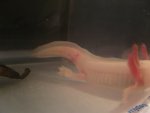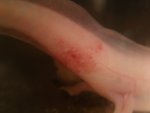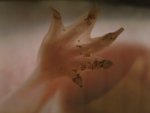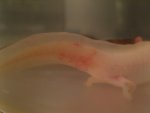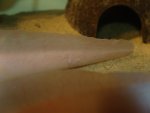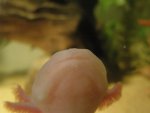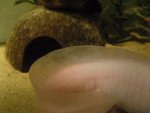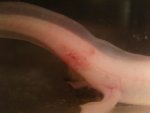Morrison
Active member
- Joined
- Jul 17, 2010
- Messages
- 1,625
- Reaction score
- 16
- Points
- 38
- Country
- Netherlands
Alright. It started all over here: http://www.caudata.org/forum/f46-be...axolotl/71567-axolotls-tail-disappearing.html
I've noticed my little albino axie has a bloody patch on it's tail and that he has his tail raised. I thought there was something stuck in him that he tried to poop out but I found out that the wound on his tail was so painful for him that he held his tail off the ground.
I tried to see if I could get a loose piece of skin off to watch under a microscope if I could find something. But when I touched it he was all freaking out and "breakdancing" and trying to "grab and bite" his tail to get rid of the pain.
Like this:
YouTube - Axie with painful wound on his tail
Right now the wound is still there. I have him separated and do daily water changes.
But now I've found out that my other axies in the other tank start to develop weird patches too. My big axie male has some loose skin on it's tail, the tail fin of my two leucistics (also the male) looks a bit.... cloudy and milky. (I'll post some pics down here).
At the bottom of their feet I notice some black parts. My albino also had some little black parts and I don't know if they turned out to this red bloody parts. Sometimes their feet look a bit red but somehow disappears. My smaller leucistic female also has a reddish little patch on her... upper lip.
I don't see anything weird on my wild types. Maybe they're too dark to see. But I guess if it affects the lighter ones why not the wildtypes?
I somehow guess it's a parasite or something that have travelled somehow (maybe the net I was using) from the one tank to the other... Or could it be the sand?
Temperature is fine (about 16 degrees) and the water parameters are still the same. kH was a bit too low when I added an almond leaf to the tank but after removing it, doing water changes it's pretty well normal again (not dangerously low).
I could get a bit of loose skin off of my axies tail and watched it under the microscope and I found something... The vid:
YouTube - Axolotl skin with parasites?
The first part of the video shows an amoeba-like slow moving thing... The second part shows a light pretty fast moving small thingy... I don't know if it's something bad. It's not the best quality but it was all I could make of it.
So... I'm really starting to freak out over here. I don't want to let them die if there's an easy way to get rid of it somehow.
So how can I help them?
Do I have to fridge them all?
Is there a medicine I can use to get rid of those beasties if that's what causes all this trouble.
Do I have to clean both tanks totally? New sand and stuff? (I also wanted to add whiter sand one day, because I can see dirty stuff better on it)
Salt baths? Tea baths? I don't know a vet around here who can also treat axies (not even reptiles when I had a sick snake a while ago).
Other things?
And I guess I have to treat them all before it gets worse or so.
Please please people. Help. I feel so bad for them and I don't want to make them suffer. It really breaks my heart when I see my little albino axie spinning around and trying to grab his tail because of the pain.
The pictures:
1. My albino with his tail rised and red painful patch.
2. Close up of how it looked yesterday. Pretty painful!
3. The bottom of my leucistics foot. (Not the dark toe tips but I mean the other darker flakes or so)
4. Tail from the side...
5. The tail of my big axie leucistic male. Also loose skin!
6. The upper lip of my leucistic female also shows a little red patch... (Not the best pic)
7. The "milky" and "cloudy" looking tail fin... I guess that's how it starts...
8. How the tail looked today. Still painful!
(Oh... and edit: Something similar I found about patches and the tail fin disappearing: http://www.caudata.org/forum/f46-be...-axolotl/52192-black-red-patches-axolotl.html But I still don't know what it is)
I've noticed my little albino axie has a bloody patch on it's tail and that he has his tail raised. I thought there was something stuck in him that he tried to poop out but I found out that the wound on his tail was so painful for him that he held his tail off the ground.
I tried to see if I could get a loose piece of skin off to watch under a microscope if I could find something. But when I touched it he was all freaking out and "breakdancing" and trying to "grab and bite" his tail to get rid of the pain.
Like this:
YouTube - Axie with painful wound on his tail
Right now the wound is still there. I have him separated and do daily water changes.
But now I've found out that my other axies in the other tank start to develop weird patches too. My big axie male has some loose skin on it's tail, the tail fin of my two leucistics (also the male) looks a bit.... cloudy and milky. (I'll post some pics down here).
At the bottom of their feet I notice some black parts. My albino also had some little black parts and I don't know if they turned out to this red bloody parts. Sometimes their feet look a bit red but somehow disappears. My smaller leucistic female also has a reddish little patch on her... upper lip.
I don't see anything weird on my wild types. Maybe they're too dark to see. But I guess if it affects the lighter ones why not the wildtypes?
I somehow guess it's a parasite or something that have travelled somehow (maybe the net I was using) from the one tank to the other... Or could it be the sand?
Temperature is fine (about 16 degrees) and the water parameters are still the same. kH was a bit too low when I added an almond leaf to the tank but after removing it, doing water changes it's pretty well normal again (not dangerously low).
I could get a bit of loose skin off of my axies tail and watched it under the microscope and I found something... The vid:
YouTube - Axolotl skin with parasites?
The first part of the video shows an amoeba-like slow moving thing... The second part shows a light pretty fast moving small thingy... I don't know if it's something bad. It's not the best quality but it was all I could make of it.
So... I'm really starting to freak out over here. I don't want to let them die if there's an easy way to get rid of it somehow.
So how can I help them?
Do I have to fridge them all?
Is there a medicine I can use to get rid of those beasties if that's what causes all this trouble.
Do I have to clean both tanks totally? New sand and stuff? (I also wanted to add whiter sand one day, because I can see dirty stuff better on it)
Salt baths? Tea baths? I don't know a vet around here who can also treat axies (not even reptiles when I had a sick snake a while ago).
Other things?
And I guess I have to treat them all before it gets worse or so.
Please please people. Help. I feel so bad for them and I don't want to make them suffer. It really breaks my heart when I see my little albino axie spinning around and trying to grab his tail because of the pain.
The pictures:
1. My albino with his tail rised and red painful patch.
2. Close up of how it looked yesterday. Pretty painful!
3. The bottom of my leucistics foot. (Not the dark toe tips but I mean the other darker flakes or so)
4. Tail from the side...
5. The tail of my big axie leucistic male. Also loose skin!
6. The upper lip of my leucistic female also shows a little red patch... (Not the best pic)
7. The "milky" and "cloudy" looking tail fin... I guess that's how it starts...
8. How the tail looked today. Still painful!
(Oh... and edit: Something similar I found about patches and the tail fin disappearing: http://www.caudata.org/forum/f46-be...-axolotl/52192-black-red-patches-axolotl.html But I still don't know what it is)
Attachments
Last edited:

